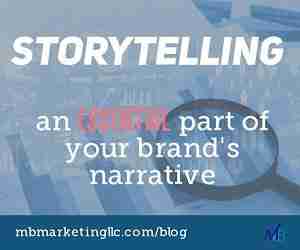No one knows when the first story in history was actually told, but it is thought that humans have been telling stories since we had the ability to speak, and maybe even before that through forms of sign language. Stories long ago helped explain the unexplainable, provide cautionary tales or to mark an occasion.
Storytelling is still important in today’s world, but why is it? Because our human brains are scientifically wired to remember stories. An average person has 2,000 breaks in focus a day, yet the brain remains focused if it is absorbing a story. Our brain chooses the information it wants to remember based upon the emotional connection we find in it. And since it has the power to change us in such a way, we simply don’t forget a great story.
Today, people are bombarded with new information like never before, so to capture the attention of customers, companies need to build a compelling story for their brand. A captivating story will tap into the audience’s emotions, build credibility and improve their recall. What customers remember and how they think about your company or organization depends on the story behind your brand and the personality associated with it.
TOMS shoes is a brand that has mastered its story. While traveling in Argentina in 2006, TOMS Founder Blake Mycoskie was intrigued with a popular shoe worn there known as the “alpargata” and believed that there might be a market it in the United States. While there, he also witnessed the hardships faced by children growing up so impoverished that they couldn’t buy shoes. Wanting to help, he created TOMS Shoes, a company that would match every pair of shoes purchased with a new pair of shoes for a child in need.
His story soon caught the attention of a Los Angeles Time
s writer, whose article about the shoes led to spreads in major magazines. Buyers from major national retailers such as Nordstrom and Urban Outfitters then placed large orders, which lead to TOMS selling 10,000 pairs of shoes by summer’s end.
Since then TOMS has extended its humanitarian efforts to include eyewear, water giving and most recently coffee, all with the same mission in mind. In partnership with customers and giving partners TOMS has impacted an incredible number of lives through its philanthropic causes.
Thinkbaby and Thinksport is another example of a give-back story. Thinkbaby and Thinksport’s founder, Kevin Brodwick, brought his interest in health and preventative medicine and his background in biotechnology together to form a company whose sole purpose is to create alternative baby and sports products for all ages. The company provides healthier, safer products while keeping the environment’s well-being in mind as well. Through its success, it has given back over $500,000 to charity.
Dave Thomas, Wendy’s fast food restaurant founder, showcased that he was a working-class person who was a part of the team, never above his employees. His story was of a man who was adopted, grew up relatively poor, dropped out of high school, got fired from multiple jobs, and yet had the integrity to build what is now the third largest hamburger chain in the world.
While Dave went through hardships early on in life, he didn’t allow his passion to
be deterred along the way. He wanted to leave a legacy that would help foster kids find quality parents for adoption, so in 1992 he created The Dave Thomas Foundation for Adoption. At one point, Wendy’s even used cups with adoption stories on them to encourage donations and participation.
Post Cereal used real factory workers in their commercials to show how cereal was packaged and delivered by real people. Diana Hunter began working for the company in 1976 and appeared in her first commercial in 2002. In 2015, she appeared as herself as a production worker in a couple of now-famous ads for Post and soon she became recognized as the unofficial face of the brand. She retired from her job at Post in 2017, but the company enticed her out of retirement recently after sales of the breakfast cereal took a nose dive.
Customers can have a huge impact on brand stories, too. There has been massive growth in peer-to-peer trust on the Internet, as people believe other people more than a brand. In fact, 92% of customers indicate they trust earned media. Companies that have found what their customers are saying and have built a story around it have been able to build credibility and interest in the brand. Salesforce.com is one such company that sets the standard on sharing its customer’s individual success stories.
In the end, customers want to connect with the brands they purchase from. They want to know who you are and how you came into existence. Not every story needs to bring tears or laughter, but it does need to be authentic and real. More and more companies are humanizing their companies by telling stories. What is yours?

